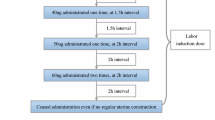Abstract
Background
Prostaglandins are popular agents for induction of labour, owing to their dual action of cervical ripening and inducing uterine contractions. Sublingual misoprostol offers high efficacy as it bypasses first-pass metabolism. Researchers have proved that intracervical PGE1 is as effective as PGE2 except for increased caesarean rate and hyperstimulation. Limited knowledge is available on the efficacy of sublingual PGE1 and intracervical PGE2. This study was designed to compare the effectiveness of sublingual PGE1 with intracervical PGE2.
Methods
A randomized control trial was conducted in Bangalore Baptist Hospital, Bangalore. One hundred and ninety women with singleton, term pregnancy were equally divided into PGE1 and PGE2 groups, and primary outcome was measured.
Results
Post-induction mean Bishop’s score in PGE1 group was statistically significant (t = 6.57, p < 0.05). Failed induction rate (1 vs 13.6 %) and need for augmentation (46.3 vs 62.1 %) were lower with PGE1 than those with PGE2 (p < 0.05). Significant (p < 0.05) maternal and foetal outcomes like higher rate of NVD (35.8 vs 26 %), lower LSCS rate (15.8 vs 32.6 %), lower incidence of foetal complications (7.3 vs 21 %) were noted with PGE1. APGAR scores at 1 and 5 min were not significant. Mean cost of induction with PGE1 was 12.55+/4.15 INR and with PGE2 470.65+/126.5.
Conclusion
Sublingual PGE1 is a better cervical ripening agent, faster and more effective, with a shorter induction-to-delivery interval as compared to intracervical PGE2. We also noted lower incidence of caesarean section and foetal distress with sublingual PGE1 compared to oral or vaginally administered PGE1.
Similar content being viewed by others
References
Eke AC, Okigbo C. Mechanical methods for induction of labour: RHL commentary (last revised: 1 August 2012). The WHO Reproductive Health Library. Geneva: World Health Organization; 2012.
WHO Global Survey on Maternal and Perinatal Health. Induction of labour data. Geneva: World health Organization; 2010.
Parmar M, Aherwar R, Jahan I. Comparative study of 25 µg vaginal misoprostol v/s cerviprime gel for induction of labour at term. Int J Reprod Contracept Obstet Gynecol. 2014;3(4):887–92.
Munzar Z. A comparison of oral misoprostol and vaginal prostaglandin E2 tablets for induction of labour at term. Pak Armed Forces Med J. 2015;65(3):301–6.
Kaur P, Kaur M, Kaur K, et al. A study of outcome of induction of labor: medical versus surgical Indian. Indian J Clin Pract. 2013;24(7):651–4.
Archana, Sharma B, Chauhan N. A comparative study of intravaginal misoprostol vs intra cervical dinoprostone gel for induction of labour. Int J Biol Med Res. 2015;6(3):5140–2.
Mahendru R, Yadav S. Shortening the induction delivery interval with prostaglandins: a randomized controlled trial of solo or in combination. J Turk Ger Gynecol Assoc. 2011;12(2):80–5.
Jha N, Sagili H, Jayalakshmi D, et al. Comparison of efficacy and safety of sublingual misoprostol with intracervical dinoprostone gel for cervical ripening in prelabour rupture of membranes after 34 weeks of gestation. Arch Gynecol Obstet. 2015;291(1):39–44.
Chaudhuri S, Mitra SN, Banerjee PK, et al. Comparison of vaginal misoprostol tablets and prostaglandin E2 gel for the induction of labor in premature rupture of membranes at term: A randomized comparative trial. J Obstet Gynaecol Re0073. 2011;37(11):1564–71.
Faucett AM, Daniels K, Lee HC, et al. Oral misoprostol versus vaginal dinoprostone for labor induction in nulliparous women at term. J Perinatol. 2014;34(2):95–9.
Jindal P, Avasthi K, Kaur M. A comparison of vaginal vs. oral misoprostol for induction of labor-double blind randomized trial. J Obstet Gynaecol India. 2011;61(5):538–42.
Tang OS, Schweer H, Seyberth HW, et al. Pharmacokinetics of different routes of administration of misoprostol. Hum Reprod. 2002;17(2):332–6.
Shehata NAA. Dinoprostone versus misoprostol vaginally for inducing labour in prolonged pregnancy. Med J Cairo Univ. 2014;82(2):187–91.
Acknowledgments
The authors thank Dr. Gift Norman, M.D., for his advice and guidance as Head of Community Health and Chairman of Scientific Committee, Bangalore Baptist Hospital, Bangalore, Dr. Sukanya, M.D., for her support as Head of the Department of Obstetrics and Gynecology, Bangalore Baptist Hospital, Bangalore, and Mr. Tata Rao for his help as Research Coordinator, Bangalore Baptist Hospital, Bangalore.
Authors’ contribution

Author information
Authors and Affiliations
Corresponding author
Ethics declarations
Ethical standards
All procedures performed in studies involving human participants were in accordance with the ethical standards of the institutional research committee and with the 1964 Helsinki Declaration and its later amendments or comparable ethical standards.
Conflict of interest
Veena B, Rajinish S, Leeberk R and Carolin E declare that they have no conflict of interest.
Informed consent
Informed consent was obtained from all individual participants included in the study.
Additional information
This study was conducted at Bangalore Baptist Hospital, Bellary Road, Hebbal, Bangalore, 560024 (Phone: 080-22024700).
Braganza Veena is Medical Director and Consultant in Obstertics and Gynaecology at Bosio Hospital; Rajinish Samal is Consultant in Department of Obstetrics and Gynaecology at Bangalore Baptist Hospital; Leeberk R. Inbaraj is Consultant in Department of Community Health at Bangalore Baptist Hospital; Carolin Elizabeth George is Consultant in Department of Community Health at Bangalore Baptist Hospital.
Rights and permissions
About this article
Cite this article
Veena, B., Samal, R., Inbaraj, L.R. et al. Sublingual Misoprostol (PGE1) Versus Intracervical Dinoprostone (PGE2) Gel for Induction of Labour: A Randomized Control Trail. J Obstet Gynecol India 66 (Suppl 1), 122–128 (2016). https://doi.org/10.1007/s13224-015-0820-8
Received:
Accepted:
Published:
Issue Date:
DOI: https://doi.org/10.1007/s13224-015-0820-8




